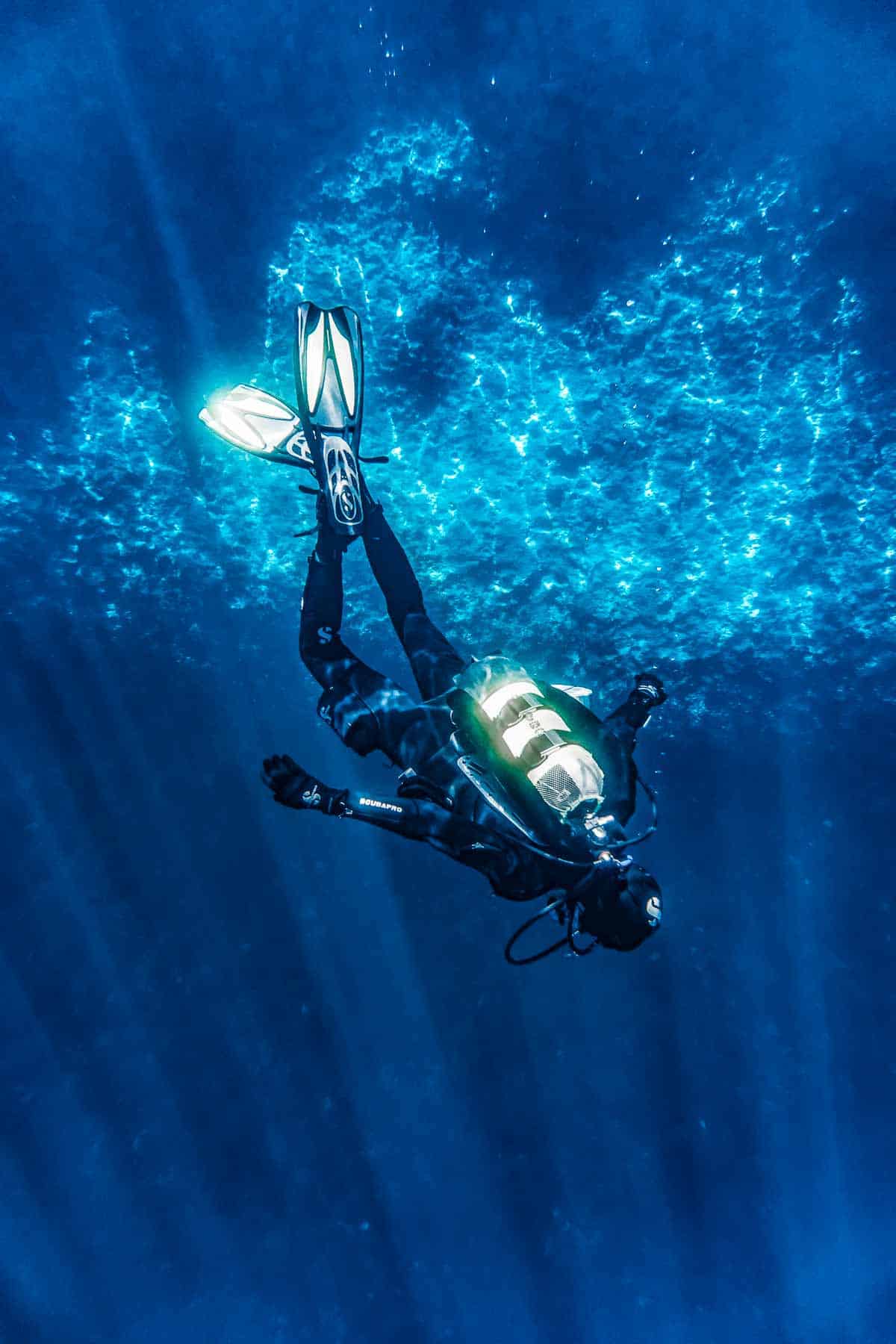Dive computers give you loads of info at a glance; depth, dive time, safety stop requirements, NDLs and more depending on the model you use. Normally you’d need to look at your SPG to see how much air you have left during a dive. Manufacturers are now offering air integrated dive computers, so you can track your air along with other details on your dive computer. These can operate wirelessly (via a transmitter attached to a regulator high-pressure port) or through a hose. Some can even track air for multiple divers which might be a useful feature for dive guides or instructors. Or if you’re using more than one tank. We’ve reviewed the ten best air integrated dive computers.
BEST AIR INTEGRATED DIVE COMPUTERS IN 2022
ALL THE AIR INTEGRATED DIVE COMPUTERS THAT WE TESTED
MARES Smart
General Impression
The Mares Smart is a compact wristwatch style dive computer that can also be worn as an everyday watch. This computer features full watch functions, including stopwatch, wake-up alarm, second time zone, and date. The user interface is simple to operate and feature customizable alerts. For Nitrox divers, the settings can be easily changed based on the blend of Oxygen and Nitrogen in your dive cylinder. The air integrated LED transmitter tracks the amount of air in your tank without having to use a hose.
Specifications
BRAND: Mares
BATTERY: Lithium metal
MEASUREMENTS: 7” x 5” x 3”
BEST FOR: Recreational Divers/Advanced Recreational Divers
WEIGHT: 19.2 oz
PROS
- LED Transmitter
- Customizable alarms
- Simple user interface
- Compact size
- Can be worn as an everyday watch
- Air and Nitrox modes
CONS
- Strap breaks easily
- Floods easily if the battery is not changed properly
SUUNTO Cobra 3
General Impression
Suunto, the Finnish company, launched Cobra 3 as an all-encompassing, wearable, hose-using, dive console. Featuring air, nitrox, and gauge operating modes, the Cobra 3 works perfectly for experienced divers. With a display that showcases oxygen partial pressures ranging from 17.4 psi to 23.2 psi (1.2 to 1.6 bars) and adjustable altitude to up to 10,000′ (3,000 meters), divers will be fully in the loop with all relevant data.
Depth-wise, Suunto’s Cobra 3 can display a maximum depth of 492′ (150 meters), and an operational depth of 262′ (80 meters). This dive console features a 12 or 24-hour clock format, while measurement data can be displayed as metric or imperial.
Specifications
BRAND: Suunto
BATTERY: Replaceable CR2450 lithium battery
MEASUREMENTS: 12.6 x 9.02 x 2.99 inches
BEST FOR: Recreational Diving
WEIGHT: 7.4 oz
PROS
- Quickly disconnectable
CONS
- Not very user-friendly
- Menu navigation is not easy
SHEARWATER Teric
General Impression
The Shearwater Teric is our top pick for the best air integrated scuba diving computer. This dive computer was designed with recreational, technical, and freedivers in mind. The settings can be changed between open and closed-circuit and set on Air, Nitrox, Trimix, or Freediving mode. After a day of diving, the user can quickly transfer their dive information to their smartphone or tablet using the Bluetooth dive log technology. The safety alerts on the Shearwater Teric can be set in either audible or vibration mode. A wrist strap extended is included for use with a thick wetsuit or a drysuit.
Specifications
BRAND: Shearwater
BATTERY: User-replaceable Lithium-Ion
MEASUREMENTS: 5” x 4.5” x 3.2”
BEST FOR: Recreational Divers/Technical Divers
WEIGHT: 12.5 oz
PROS
- Audible or vibration alerts
- Wrist strap extender
- Open-circuit and closed-circuit Air, Nitrox and Trimix modes
- Freediving mode
- Bluetooth dive log transfer capability
CONS
- No bungee mount option
- Sun causes screen glare
SUUNTO Vyper Novo
General Impression
When it comes to air integrated dive computer reviews, the Suunto Vyper Novo is one of the best. This dive computer features a built-in compass to keep you on track during dives and has a deep stop option for more advanced divers. This wrist dive computer can be easily switched between Air, Nitrox, gauge, and freediving modes. The wrist strap is durable and long enough to fit over a wetsuit, and the screen display is large enough that it can be easily read underwater.
Specifications
BRAND: Suunto
BATTERY: User-replaceable CR2450
MEASUREMENTS: 5” x 5” x 5”
BEST FOR: Recreational Divers/Advanced Recreational Divers
WEIGHT: 11.2 oz
PROS
- 3D compass
- Air, Nitrox, Gauge, and Freediving modes
- Durable strap
- Deep stop option
CONS
- No wireless data transfer
- One color option
SUUNTO Eon Core
General Impression
The Suunto Eon Core is a top pick for advanced recreational and technical divers who are interested in hoseless air integration. This wrist dive computer comes in three color options and features a full-color customizable display screen. The elastomer wrist strap is flexible and can be worn over a wetsuit or drysuit. For technical divers, this dive computer can be changed between Air, Nitrox, Trimix, and CCR modes. The Suunto Eon Core provides up to 200 hours of logbook memory, and the data is easily transferred using Bluetooth wireless technology.
Specifications
BRAND: Suunto
BATTERY: User-replaceable Lithium-Ion
MEASUREMENTS: 7” x 4” x 4”
BEST FOR: Advanced Recreational Divers/Technical Divers
WEIGHT: 12.8 oz
PROS
- Large color display
- Intuitive menu
- Elastomer strap
- Gauge, Air, Nitrox, Trimix, and CCR modes
- 200-hour logbook memory
- Bluetooth connectivity
CONS
- Bungee strap kit is expensive
- Bulky on wrist
SCUBAPRO G2
General Impression
The Scubapro G2 is a robustly designed air-integrated wrist computer. The full-color display is easy to read and can be customized based on the user’s preference. This wrist dive computer features a predictive multi-gas algorithm and can be switched between Air, Nitrox, and freediving modes. For technical divers, the Scubapro G2 is a popular choice with the ability to select from eight Nitrox or trimix mixes. This is one of the best hoseless dive computers and tracks the diver’s breathing rate to calculate diving profiles accurately.
Specifications
BRAND: Scubapro
BATTERY: Lithium-Ion
MEASUREMENTS: 6” x 5.5” x 4”
BEST FOR: Advanced Recreational Divers/Technical Divers
WEIGHT: 17.6 oz
PROS
- Full-color LCD screen
- Display customization
- Nitrox, Freediving, and Air modes
- Compact square design
- Predictive multi-gas algorithm
CONS
- Optional bungee strap not included
- Strap is stiff
SCUBAPRO Mantis 2.0
General Impression
Scubapro’s Mantis Series include dive computers that come backed up with a transmitter. Besides including a heart rate monitor, this diving companion is also boasting smart technology that gathers all relevant info like air integration data and predictive multi-gas info. Also displaying microbubbles levels and a full-tilt compass, the Mantis 2.0 will meet the needs of every recreational diver. The easy-to-read display is adorned with four control buttons made of metal, all enabling seamless navigation through the menu.
Specifications
BRAND: Scubapro
BATTERY: Replaceable AA battery
MEASUREMENTS: 7 x 5 x 2 inches
BEST FOR: Recreational and Technical Diving
WEIGHT: 27.2 oz
PROS
- User-compatible
- Ergonomic design
- Electronic navigation
CONS
- The metal buttons are not easy on the fingers
- The menus might not be easy to find
SUUNTO Eon
General Impression
This piece of cutting-edge technology is designed for wrist-wearing, offering an intuitive, user-friendly experience when delving into the deep blue.
It’s mostly suitable for experienced divers, used for technical diving. Thanks to its high-def screen, the info is easily readable, displaying large numerals, and a notable battery life indicator. Gasses-wise, there are up to 10 Nitrox gasses, and it’s Trimix compatible. Boasting a rechargeable battery that lasts for up to 40 hours, this dive computer is designed by divers, for divers.
Specifications
BRAND: Suunto
BATTERY: Rechargable
MEASUREMENTS: 6.06 x 5.79 x 4.88 inches
BEST FOR: Technical Diving
WEIGHT: 12.2 oz
PROS
- Durable
- Long-lasting battery
- Advanced in-dive notifications
CONS
- Rather heavy, weighing 12.2 oz
- Bulky design
- Moves around the wrist
OCEANIC VTX
General Impression
Featuring an ultra-bright, full-color OLED display in high contrast, this trending tech gadget comes with an intuitive color label of critical dive data. Offering Bluetooth features for wireless transfer, Oceanic’s VTX will deliver all relevant data for a diver.
Designed with a 3-axis digital compass, full tilt compensation, 4 Nitrox mixes – each with individual PO2 set points, and automatic Safety Stop countdown, this diving companion is packed with numerous perks.
Specifications
BRAND: Oceanic
BATTERY: Rechargable
MEASUREMENTS: 8.5 x 6 x 3.25 inches
BEST FOR: Recreational and Technical Diving
WEIGHT: 24 oz
PROS
- Countdown timer
- Slim, ergonomic design
- OLED screen
- Compass
CONS
- The display is difficult to read in the sunlight
OCEANIC Pro Plus x
General Impression
The Oceanic Pro Plus air integrated console dive computer is highly-rated for those who may need assistance reading their display. The smart glow backlight sensor is even more helpful in murky waters or on a night dive, and the color-coded interface improves the user experience. The Oceanic Pro Plus features a digital compass for ease of navigation and can be switched from Air to Nitrox mode for divers using enriched air.
Specifications
BRAND: Oceanic
BATTERY: User-replaceable Lithium-Ion
MEASUREMENTS: 7” x 4” x 4”
BEST FOR: Recreational Divers/Advanced Recreational Divers
WEIGHT: 16 oz
PROS
- Digital compass
- Large, color display screen
- Air, Nitrox and Gauge modes
- Smart glow backlight sensor
CONS
- Confusing dive log interface
- Buggy software
BEST AIR INTEGRATED DIVE COMPUTERS
Buyer's Guide
Whether you are new to scuba diving or a seasoned diver, choosing a dive computer can be a big decision. Dive computer technology has improved tremendously in recent years, and a popular choice among divers old and new is the air integrated dive computer. All dive computers are equipped with essential functions that track your depth, time, maximum depth, water temperature, and no-decompression time. Other basic features include alerts for safety stops, deep stops, and ascent rates.
Before air integrated computers, divers monitored the amount of air in their scuba cylinders by using a submersible pressure gauge (SPG). The submersible pressure gauge, just like an air integrated computer, screws into the high-pressure port of a regulator. Even with an air integrated computer, some divers prefer to keep their SPG as a backup in case of computer failure on a dive. Other divers prefer to replace the SPG to streamline their gear by only using a wireless air integrated computer.
Wireless vs. Hose
Air integrated dive computers are designed in two different ways. With a wireless air integrated dive computer, there is no need for a hose to monitor the air in a scuba cylinder. Using advanced wireless technology, a transmitter that screws into the high-pressure port of a regulator tracks the amount of PSI or BAR in a scuba tank and sends the reading wirelessly to the diver’s wrist computer.
The most reviewed air integrated dive computers are wireless, as many divers prefer to lessen the number of hoses on their regulator set. Some wireless models, like the Oceanic OCi, can track more than one transmitter. For technical divers, this is a huge plus, especially when diving with a side mount setup or diving with multiple tanks.
Air integrated dive computers with a hose are quite popular in the United States. This type of dive computer is a console-style where the computer fits into a boot that attaches to a hose onto your regulator. The air tracking process is similar to a wireless computer, except the air consumption rate is measured through the pressure in the hose. For divers using this type of computer, it is essential to store your regulator safely so the dive computer does not get damaged since it will always be attached to your regulator. Many divers prefer to purchase a high-pressure quick disconnect so that they can remove the computer from their regulator after each use. The Suunto Cobra is one example of an air integrated console dive computer that can be upgraded with a quick disconnect.
As divers become more experienced and try different types of computers, they will choose which style they like best that fits their diving needs.
Extra Features
In addition to the standard features included in dive computers, there are loads of extra features that make top-rated stand out from the rest. For divers who have trouble with their vision on the surface or underwater, manufacturers have designed computers with larger displays, larger characters, and even screens that are full color or color-coded. The Suunto Eon Core and the Scubapro G2 also give divers the option to customize their screen display to increase readability underwater.
For the larger wristwatch style dive computers with more technical diving features, some brands include a bungee wrist strap or watch strap extender to make it easier to fit the dive watch over a thick wetsuit or a drysuit. Other watch style dive computers are low profile enough to be used as an everyday watch and have wake-up alarms, two-time zone settings, and stopwatch modes.
Dive log firmware is usually a standard offering in any type of dive computer, whether it be air integrated or a basic scuba diving computer. Our top pick for the best air integrated dive computers, the Shearwater Teric, uses Bluetooth technology so that divers are able to quickly transfer their dive information to their smartphone or tablet after a day of diving. Another highly-rated Shearwater Research product is the Shearwater Perdix. This dive computer also is equipped with Bluetooth technology, but it can also store a massive 1,000 hours of dive log information.
Customizable safety alarms and alerts are another well-liked extra feature for all types of divers. The Mares Smart is a compact wristwatch style air integrated dive watch that allows users to customize the safety alarms on their device. The Shearwater Research Teric also has this option, letting divers choose between audible alarms or vibration mode. The Scubapro Galileo Luna can be connected to a Scubapro heart rate monitor to track skin temperature, heart rate, and breathing rate, which helps with the calculation of no-decompression limits and dive profiles.
For the stylish scuba diver or freediver, companies like Suunto, Mares, and Oceanic produce dive computers with multiple color options. So for the next dive trip to the Caribbean, you can purchase a dive computer that matches your fins, wetsuit, or even your buoyancy control device (BCD).
Freediving is becoming more and more popular around the world with the introduction of PADI’s (The Professional Association of Diving Instructors) Basic Freediver and Advanced Freediver courses. If you are a freediver and a scuba diver, you will want to choose a dive computer that has a freediving mode, and it can also have the air integrated option for your scuba diving needs. For advanced freedivers and technical freedivers, the Oceanic OCi includes a technical freediving mode to keep track of your deep dives.
Dive Computer Maintenance
Taking care of your air integrated dive computer is an integral part of the scuba diving process. A dive computer keeps track of your dive profile and sets limits using an algorithm to keep you safe underwater, so being sure it is fully operational is essential. Anytime you go for a dive in freshwater or saltwater; you should always rinse your gear with fresh water after a dive to keep it nice and clean. This will ultimately extend the life of your diving equipment. Most dive gear supplies recommend soaking your dive computer in freshwater for at least five minutes while pushing the buttons to free them of any salt that could build up after a dive. If your dive computer is connected to your regulator, you can soak the entire set together. After cleaning a dive computer, it should always be stored in a carrying case in a cool, dry place to protect it while it is not in use. Most manufacturers include a protective case in your initial purchase, and if not, you may have to buy one. Always read the manufacturer instructions for each piece of dive gear you have to be sure you are following the correct procedures. This is important for a dive computer battery, as well. Batteries last for one to two years, on average, depending on the brand and will have special instructions for replacement. When in doubt, get a certified product specialist or dive gear supplier to assist with replacing the battery in your dive computer to ensure the o-ring and back are sealed to prevent water leakage while diving.
BEST AIR INTEGRATED DIVE COMPUTERS
FAQs
1. What is a dive computer used for?
Before the invention of dive computers, divers used dive tables based on theoretical data to calculate the amount of Nitrogen in their bodies during a dive or multiple dives. Dive computers use algorithms based on those theories that automatically calculate residual Nitrogen, so you have access to the information while diving, instead of having to wait to do the calculations in between dives. Because every person is different, and we do not always dive the exact same profile as our buddy, a dive computer tracks the precise depths we visit, making the data even more accurate. Based on the algorithm, some dive computers are more conservative than others; your computer will keep track of your dive profile and alert you when you are approaching your no-stop limits. Dive computers also alert you if you are ascending too quickly, or need to make a deep stop during deeper dives.
2. What are air integrated dive computers?
Air integrated dive computers have become more common over the years. This type of computer can either be wirelessly connected to your dive computer display using a transmitter or through a hose connected to the high-pressure port of your regulator. An air integrated dive computer usually replaces the traditional submersible pressure gauge, which tracks your air consumption during a dive. The traditional SPG uses a pressure and needle system where the needle changes position as the air in your tank is consumed. Air integrated dive computers show this information on your screen, either in a console or wristwatch style, along with your depth time, water temperature, and other dive profile information depending on the type of computer you choose. Some dive computer models for technical diving can connect to more than one transmitter when diving with multiple tanks.
3. What is the best air integrated dive computer?
When choosing the best air integrated dive computer for you, there are a few things to consider. The first thing is, do you want a computer that is built into your regulator set? This is called a console-style, and the dive computer fits into a boot that attaches to your regulator high-pressure port so that your tank pressure can be read and displayed on your screen. Some of these models feature a quick-disconnect option so you can remove the computer portion and store it when not in use. The other option is to purchase a wrist dive computer with a wireless transmitter. This type of computer is hoseless, fits on your wrist like a watch, and the transmitter wirelessly connects to your wrist computer to show you the amount of air in your scuba cylinder. You may also want to consider the price. The prices for air integrated computers vary so if you are a beginner you can find a suitable computer for a reasonable price. If you are a technical diver, you will have to pay a bit more to get the increased functionality you need.
4. What is the best cheap air integrated dive computer?
Our top pick for the best value in an air integrated dive computer is the Suunto Cobra console computer, which can be purchased for under $400. Mares and Oceanic also offer affordable options for air integrated computers. The Suunto Vyper Novo, the Mares Smart, and the Oceanic OCi are all wrist computers and can be purchased for under $750. For beginner divers, all of these dive computers provide a simple user interface, easy to read screens, and the basic functionality you will need for recreational scuba diving. Some also have the capability to be changed to Nitrox or freediving mode if you plan to use them for these types of diving. If you are looking for a computer with a built-in compass, there are quite a few cheap air integrated computers to choose from, and most can be worn as an everyday watch, a win, win.
5. Hose vs. Wireless?
Air integrated dive computers come in both hose or wireless versions. Dive computers that have a hose are connected to the high-pressure port of your regulator. Some models offer an upgrade to a quick-disconnect version so that the computer can be removed from the high-pressure hose for storage when not in use. Wireless dive computers are hoseless and connect to a wireless transmitter that screws into the high-pressure port of your regulator. Just as the hose style does, the wireless form monitors your air supply and displays it on your computer screen. Some models will also monitor your breathing rate and show the exact amount of dive time you have remaining based on your breathing rate. Wireless models can connect to at least one transmitter, while higher-end dive computers for technical diving will connect to multiple transmitters to keep track of the air in more than one scuba cylinder. This is a popular choice for divers using a side mount gear setup.
REACH OUT
As always, we create our content with you, fellow adventurers, in mind. So, how’d we do? Did you find this informative? Did it help you make a decision? Did we miss anything? We’d love to hear from you below. Thanks for reading and we hope your next adventure is a great one!








































